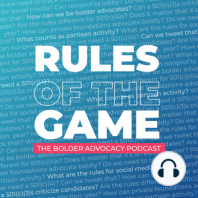13 min listen

Lobbying Series Part 6 - Redistricting
Lobbying Series Part 6 - Redistricting
ratings:
Length:
21 minutes
Released:
Mar 24, 2021
Format:
Podcast episode
Description
On this episode, we’ll be talking about that special once a decade process of redistricting. Because this is the sixth episode in our lobbying series, we’re describing this as your midterm test, applying our lobbying and advocacy 101 podcasts to a particular policy proposal: redistricting. Attorney Co-hosts Jen Tim Quyen A brief civics lesson about redistricting—the process by which the states draw lines on a map to create electoral districts. The census is constitutionally required in part because our federal house of representatives originally kept growing to proportionally represent an entire state’s population. Fun facts: Because the house of representatives kept growing as our country grew, Congress adopted a “cap” of 435 house members under the Apportionment Act of 1911. That cap is still alive today. For redistricting at the federal level then, every census requires we count each individual. Then the Congress apportions the 435 seats to the states based on the population changes. In other words, Congress gets to reassign some seats to states with big populations so that they get a “larger voice” in the house of representatives. Once apportioned, the last step is that a state process occurs and lines on a map are drawn to determine the districts for those federal elected officials as well as state and local elected seats. Since we’re dealing with Covid still, the timelines for this process have been pushed. There’s plenty of time for you to get involved and make your voice heard. Are all states the same? Of course not! Because states are permitted to draw the lines, every state has a unique approach with some states allowing the state legislature to vote on the map while others provide a bi-partisan or other type of citizen driven commission. Redistricting rules of the road While it would be fun to discuss the laws and legal standards about how to draw a district –things like ensuring roughly an equal number of voters in each district, and that districts do not unfairly pack certain voters into one space while cracking geographic or other affinity groups into multiple districts. This podcast is about what you—as a public charity or a private foundation—can do in your state around this process. So what does that mean: it means lobbying for equality and justice in states where the legislature must approve the maps. It can also mean plain old advocacy in states where there is a commission adopted to deal with this process. For example, in California, there’s a commission that draws the maps and it is made up only of citizens that apply and go through a rather lengthy process. This means advocacy to the commission is not lobbying. Since the commission is formed though, so long as it has the final authority to finalize the map of the districts, then any work contacting the commissioners, appearing before the commission, even drawing your own map and providing it to the commissioners will not be considered lobbying. Since every state does this process a little different, check out our links below that will take you directly to how your state conducts this process. In contrast, in Texas, as in most states, redistricting still requires the state legislatures to adopt the maps. For a public charity, this means working with legislators on redistricting is lobbying. As a public charity, you can always lobby on items that your legislature has to vote on and maps drawn by the legislators for how you elect your representatives is no different. Your lobbying can include items that address the historical discriminatory patterns related to race, but also items that make your community unique. Some items that can generally be looked at include: Income levels Housing patterns (suburban, rural etc) Language or cultural identification Environment
Released:
Mar 24, 2021
Format:
Podcast episode
Titles in the series (98)
The Day After: Tim, Natalie and Leslie discuss the role nonprofits are playing the day after the 2020 election, including examples of messaging now, a look ahead to what may come, plus a look back at the remarkable work nonprofits did to get out the 2020 vote. by Rules of the Game: The Bolder Advocacy Podcast